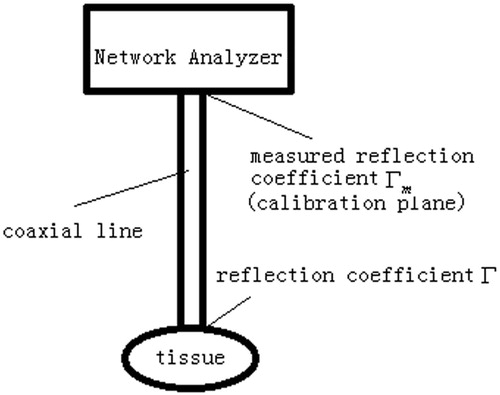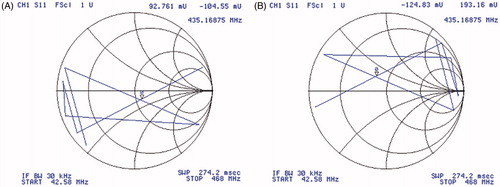Abstract
Purpose: This study aimed to obtain the temperature- and frequency-dependent dielectric properties of tissues subjected to magnetic resonance (MR) scanning for MR imaging-guided focused ultrasound surgery (MRgFUS). These variables are necessary to calculate radio frequency electromagnetic fields distribution and specific radio frequency energy absorption rate (SAR) in the healthy tissues surrounding the target tumours, and their variation may affect the efficacy of advanced RF pulses. Materials and methods: The dielectric properties of porcine uterus, liver, kidney, urinary bladder, skeletal muscle, and fat were determined using an open-ended coaxial probe method. The temperature range was set from 36 °C to 60 °C; and the frequencies were set at 42.58 (1 T), 64 (1.5 T), 128 (3 T), 170 (4 T), 298 (7 T), 400 (9 T), and 468 MHz (11 T). Results: Within the temperature and frequency ranges, the dielectric constants were listed as follows: uterus 49.6–121.64, liver 44.81–127.68, kidney 37.3–169.26, bladder 42.43–125.95, muscle 58.62–171.7, and fat 9.2327–20.2295. The following conductivities were obtained at the same temperature and frequency ranges: uterus 0.5506–1.4419, liver 0.5174–0.9709, kidney 0.8061–1.3625, bladder 0.6766–1.1817, muscle 0.8983–1.3083, and fat 0.1552–0.2316. Conclusions: The obtained data are consistent with the temperature and frequency ranges typically used in MRgFUS and thus can be used as reference to calculate radio frequency electromagnetic fields and SAR distribution inside the healthy tissues subjected to MR scanning for MRgFUS.
Introduction
Magnetic resonance imaging-guided focused ultrasound surgery (MRgFUS) is a promising technique used to conduct thermal ablation of fibroid or other types of tumours because this technique exhibits non-invasive properties. Magnetic resonance imaging (MRI) and thermometry can be performed to guide and monitor focused ultrasound thermal surgery to ensure that temperature is safely controlled. Understanding the distribution of radio frequency (RF) electromagnetic fields inside human tissues subjected to MR scanning for MRgFUS is very helpful to improve MR techniques applied in an MRgFUS system such as in designing RF coils and advanced RF pulses [Citation1]. Furthermore, the safe control of energy absorption typically quantified at a specific absorption rate (SAR) deposited in healthy tissues subjected to MR scan is important in high-field MRI. The dielectric parameters of tissues are also considered to calculate RF electromagnetic fields and SAR distribution in tissues subjected to MR scan [Citation1,Citation2]. The dielectric parameters of such tissues are inherently temperature dependent. During the MRgFUS treatment, the targeted tissues can be heated up to a temperature of 60 °C, such as with the Exblate 2000 and 3000 systems developed by Insightec (Haifa, Israel), by releasing focused ultrasound energy, and thus a temperature gradient distribution can be established centred at the ultrasound focus and extended to the surrounding tissues [Citation3,Citation4]. Dielectric properties are also inherently varied at different resonance frequencies of MRI systems. However, temperature- and frequency-dependent dielectric properties of tissues within the temperature and frequency ranges typically used for MRgFUS, that is, temperature range of 36–60 °C and discrete resonance frequencies at MHz of 42.58 (1 T), 64 (1.5 T), 128 (3 T), 170 (4 T), 298 (7 T), 400 (9 T), and 468 (11 T) have been only partially studied.
Frequency-dependent dielectric properties of biological tissues have been thoroughly investigated by Gabriel et al. [Citation5–7]. Other researchers continuously contribute to the investigation of temperature-dependent dielectric properties of biological tissues. A brief summary of related research on temperature-dependent dielectric properties of biological tissues presently available is listed in . For instance, Schwan and Kam [Citation8] studied the dielectric properties of human autopsy materials at discrete frequencies of 200, 400, and 900 MHz and temperatures of 25° and 42 °C. Foster et al. [Citation9] investigated the temperature- and frequency-dependent dielectric constant and conductivity of canine brain tissue at a frequency range of 0.01 GHz to 10 GHz and a temperature range of 22–25 °C and 37 °C. Semenov et al. [Citation10] studied the dielectric properties of canine myocardium at a frequency range of 0.2–6.0 GHz and a temperature range of 23–37 °C. Jaspard and Nadi [Citation11] investigated the temperature- and frequency-dependent dielectric constants and conductivities of human blood as well as cow and sheep blood at a frequency range of 0.001–1.0 GHz and a temperature range of 25–45 °C. Johnson and Guy [Citation12], Schwan and Foster [Citation13], Chin and Sherar [Citation14,Citation15], Stauffer et al. [Citation16], Brace [Citation17], Zurbuchen et al. [Citation18], Delonzor et al. [Citation19], Karacolak [Citation20], and Lopresto et al. [Citation21] also studied the temperature- and frequency-dependent dielectric properties of tissues at various frequency and temperature ranges. However, these dielectric properties of tissues are partially observed at temperature and frequency ranges typically used for MRgFUS. In some studies, approximate linear temperature coefficients are proposed to determine the unknown dielectric properties. However, linear temperature coefficients can result in serious errors at wide frequency and temperature ranges [Citation22] because dielectric properties are not always linear at temperature and frequency ranges typically used for MRgFUS. In summary, complete temperature- and frequency-dependent dielectric properties of tissues during MRgFUS are unavailable.
Table I. Chronological summary of previously published temperature-dependent dielectric properties of various biological tissues.
In our study, the temperature- and frequency-dependent dielectric properties of porcine uterus, liver, kidney, urinary bladder, skeletal muscle, and fat at temperature and frequency ranges typically used for MRgFUS were determined. The temperature range was set from 36 °C to 60 °C, and included the discrete frequencies of 42.58, 64, 128, 170, 298, 400, and 468 MHz. The open-ended coaxial probe method [Citation23] was used to measure the reflection coefficient; the conductivity and dielectric constants of the tissues were calculated accordingly. The data obtained can be used to calculate the electromagnetic field and SAR distribution in tissues subjected to MR scan for MRgFUS.
Methods
Principle of open-ended coaxial line method
In contrast to other methods used to determine dielectric properties, the open-ended coaxial probe method is suitable to determine semi-solid materials, such as biological tissues, because this method requires non-destructive operation, simple sample preparation, and convenient temperature control [Citation24]. In this section, the principle involved in this method and the mechanism by which the final conductivity and dielectric constant are determined from are briefly summarized. The complex relative permittivity
of a material can be expressed as follows:
where
is the dielectric constant of the material and
is the dielectric loss factor.
is composed of ionic conduction and dipole rotation as expressed in Equation 2 [Citation25]:
where
represents the dipole rotation,
stands for the ionic conduction in S/m,
is the permittivity of free space (8.854 × 1012 F/m), and
is the angular frequency in rad 1/s. In an experimental measurement, the contributions of
and
are difficult to separate; thus, a frequency-dependent conductivity
is defined [Citation26]; the complex relative permittivity can be expressed as follows:
Thus, can be determined from the real part of
, and the conductivity
can be determined from the imaginary part of
. The complex relative permittivity of tissues can be obtained from the reflection coefficient by using the open-ended coaxial probe method [Citation23]. The equivalent circuit of the open-ended coaxial probe method in this study is shown in .
Figure 1. Equivalent circuit of the open-ended coaxial probe method. is the equivalent capacitor corresponding to the fringing field in Teflon,
is the capacitance accounting for the fringing field in air, and
is the complex relative permittivity.
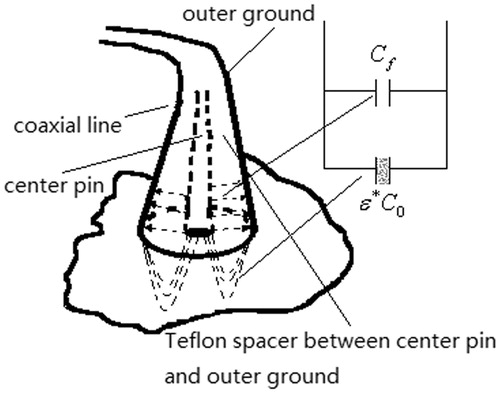
In , accounts for the fringing field in Teflon and
is the capacitance when the line is in air. In our frequency range,
is assumed constant;
and
can be determined empirically from the data of the samples with known dielectric properties, such as 99.9% methyl alcohol at 28.0° ± 0.1 °C and 99.8% NaCl dissolved in water at 25.0° ± 0.1 °C [Citation26]. The radiating effect is negligible because the discrete frequencies in this study are <500 MHz [Citation23,Citation27]. At the tip of the coaxial probe in this model, the relationship between the reflection coefficient
and the load impedance
is shown below:
where
is the characteristic impedance of the coaxial line. The load impedance
is calculated as follows:
where
is the complex relative permittivity. Equations 4 and 5 show that
is determined if
is obtained; the conductivity and dielectric constants of the tissues can be finally determined based on
.
at the probe tip is different from the measured reflection coefficient
(S11) obtained using a network analyser () because the losses and radiation in the coaxial line are non-negligible [Citation26]. In this research, a method involving open, short, and standard liquid load terminations was used to eliminate systematic errors [Citation26]. Open termination was established by placing the line in free space; short termination was attained by pressing the tip of the line on a thin indium sheet (or aluminium foil); and standard liquid termination was reached by immersing the probe into deionized distilled water, in which the permittivity of water is already known [Citation28]. Using the calibration scheme proposed by Bao et al. [Citation29], we can determine
without requiring specific knowledge of
and
.
Preparation of biological tissues and measurement system
Porcine uterus, liver, kidney, urinary bladder, skeletal muscle, and fat were used as samples. From each tissue, three samples were obtained from three different female pigs that were about 30 months old. Because the breakdown of cellular structures and cell membrane functions caused by cell death profoundly changes the dielectric properties of biological materials [Citation13], we transported all of the samples to our laboratory from a slaughterhouse in less than 2 h after excision. Each sample was wrapped in a preservative film to minimize liquid loss because the dielectric constant significantly depends on the content and the state of water (free and bound) inside the tissues [Citation30]. Therefore, the change in temperature was the only main factor causing the dielectric properties of tissues to change at various discrete frequencies.
The measurement system consists of a network analyser (Agilent 4395A, Santa Clara, CA) associated with an S-parameter test set (Agilent 87511A). A semi-rigid coaxial line with a size of 0.141in/0.358 cm (outer diameter) was connected to the network analyser system by using a Bayonet Neill-Concelman connector. The other tip of the line was fully connected (not inserted) to the surface of tissues. No air between the coaxial probe and the tissue is permitted because air can result in significant errors. The probes of the digital micro-thermometers were inserted into the samples, which were packaged in a preservative film and placed in a water bath chamber. To keep the tissues inside the water, we used magnets to fix the preservative film on the salver of the water bath incubator. While immersed in water, the preservative film could closely come in contact with the tissues because of water pressure, ensuring that heat is effectively conducted to the tissues ().
Figure 3. Diagram of the measurement system. 1, coaxial line; 2, digital micro-thermometer (used to measure tissue temperature); 3, water bath incubator (used to control water temperature); 4, heater (used to heat water); 5, salver (used to place the tissues); 6, magnet (used to fix the tissues); 7, preservative film (used to pack the tissues); 8, thermometer probe; 9, water.
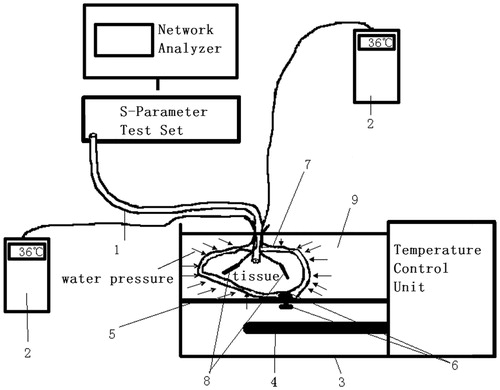
The samples were heated and stably maintained at different temperatures from 36 °C to 60 °C at an interval of 3 °C. The dielectric properties of each sample at each discrete frequency of 43, 64, 128, 170, 298, 400, and 468 MHz and at each stable set point temperature were determined. During the procedures of measurement, each sample was measured three times at each position to ensure data reliability, and three different positions of each sample were selected to assess the spatial variation of dielectric properties.
Calibration of possible errors
A few possible improper arrangements prone to errors have been reported using the open-ended coaxial probe method [Citation31]. In this experiment, numerous possible improper arrangements were observed. Some of these possible improper arrangements, which will cause errors, are listed as follows:
The coaxial line tip is not flat.
The coaxial line is partially connected to the tissues.
The probe is partially connected to the indium sheet (or aluminium foil) when the short-circuit termination is established.
Air bubbles appear at the probe tip when the probe is inserted into the tube filled with deionised distilled water.
The proper arrangements to correct the aforementioned errors are listed as follows:
The coaxial line tip should be filed until it is flat enough.
The pressure should be slightly adjusted to allow the probe to fully connect (not inserted) to the tissue surfaces; Smith chart obtained using the network analyser should be observed (). A stable reflection coefficient indicates that the probe is fully connected to the tissue surfaces.
The probe should be tightly pressed onto the indium sheet or aluminium foil until the shape of the Smith chart display () is stable, indicating that a qualified short-circuit termination was established.
The presence of bubbles at the probe tip should be observed. These bubbles should then be removed.
Results
The temperature-dependent dielectric constant and conductivity in terms of mean values and corresponding standard uncertainties, U, for which a coverage factor K = 2 was applied to obtain a confidence interval (CI) of 95% [Citation20,Citation21], of different porcine tissues at various discrete frequencies subjected to MRI, are shown in .
Figure 5. Temperature-dependent dielectric properties of porcine tissues at 43 MHz, with mean values and uncertainty margins of the dielectric constant and electric conductivity.
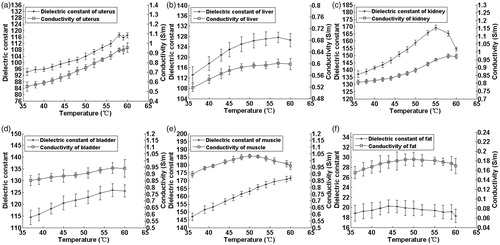
Figure 6. Temperature-dependent dielectric properties of porcine tissues at 64 MHz, with mean values and uncertainty margins of the dielectric constant and electric conductivity.
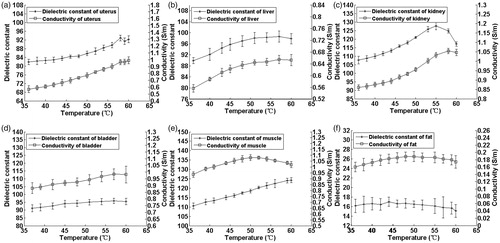
Figure 7. Temperature-dependent dielectric properties of porcine tissues at 128 MHz, with mean values and uncertainty margins of the dielectric constant and electric conductivity.
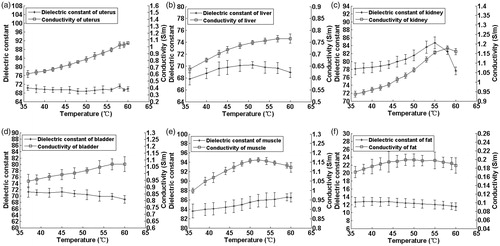
Figure 8. Temperature-dependent dielectric properties of porcine tissues at 170 MHz, with mean values and uncertainty margins of the dielectric constant and electric conductivity.

Figure 9. Temperature-dependent dielectric properties of porcine tissues at 298 MHz, with mean values and uncertainty margins of the dielectric constant and electric conductivity.
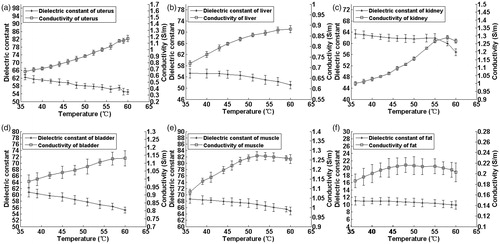
Figure 10. Temperature-dependent dielectric properties of porcine tissues at 400 MHz, with mean values and uncertainty margins of the dielectric constant and electric conductivity.
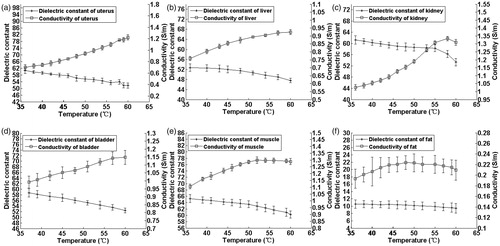
Figure 11. Temperature-dependent dielectric properties of porcine tissues at 468 MHz, with mean values and uncertainty margins of the dielectric constant and electric conductivity.
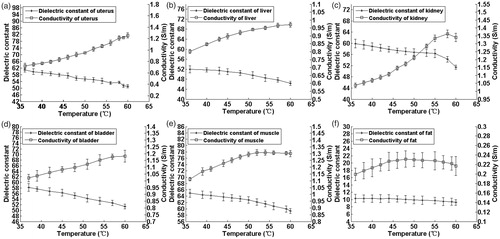
For clarity, maxima of uncertainties of the dielectric constant and conductivity of the measured porcine tissues are reported in . The standard uncertainties of temperature measurements are less than 4.81%, while the standard uncertainties of conductivity and dielectric constant are less than 10.62% and 11.28%, respectively. In this measurement, the accuracy of the dielectric probe is ±5%, thus the combined standard uncertainties of conductivity and dielectric constant are less than 16% and 17% respectively.
Table II. Maxima of standard uncertainties of the dielectric constant and conductivity of the tissues in this study.
Results in term of range of variation of the dielectric constant and conductivity at 45 °C, over N = 3 tissue samples, are reported in . The corresponding mean values of the dielectric constant and conductivity can be obtained from .
Table III. Range of variation (N = 3) of the dielectric properties at 45 °C, at different discrete frequencies. Mean values of dielectric properties of different tissues at different frequencies can be obtained from .
Discussion
It is necessary to compare the obtained results with those data existing in the literature. We found that the dielectric constant and electric conductivity of four tissues, i.e. the uterus, liver, kidney, and muscle in our study, were partially comparable with existing data. All of the overlapped data compared with those in previous studies were carefully enumerated, although only a small portion of the measured data were overlapped with those reported in previous literature. For the comparable data, most of the results of this study fitted well to those in previous studies [Citation6,Citation32], indicating the reliable results ().
Table IV. Comparison of the comparable dielectric constants of the biological tissues between this study and previous studies [Citation6,Citation32].
The obtained results showed that the temperature-dependent dielectric constants of the tissues except fat at 42.6 and 64 MHz were higher than those at higher frequencies. This result may be caused by β and δ dispersions [Citation33]. The dielectric constant of fat did not exhibit this property because fat contains low amounts of water and protein.
As temperature increases, dramatically varying dielectric properties may be observed. The temperature-dependent conductivities of all tissues increased as temperature increased from 37 °C. For some tissues the conductivity decreased as temperature further increased above 50° to 60 °C. Although increase or decrease in conductivity due to differing contributions from dipolar and ionic components as a function of temperature has been reported previously [Citation34], this was for a much higher frequency than used here and we are uncertain of the relevance to our study. This result occurs because the dielectric properties of tissues depend on the water content of tissues, state of water, ionic conductivity, dielectric relaxation of protein, and Maxwell-Wagner relaxation [Citation30]. As temperature increased, cellular structure disruption, water loss, and protein degeneration may become serious, resulting in variation to large extent. In this study, seriously degenerated and dried tissues were observed after the samples were heated to 60 °C.
Conclusion
In this study, the temperature- and frequency-dependent dielectric properties of porcine uterus, liver, kidney, urinary bladder, skeletal muscle, and fat were determined within the temperature and frequency ranges typically used for MR scan in the MRgFUS treatments. The dielectric properties can be clearly and directly obtained from . These data can be used as basic information to calculate RF electromagnetic field and SAR distribution inside the healthy tissues subjected to MR scan in the MRgFUS treatment.
Declaration of interest
This study was partially supported by the Major State Basic Research Development Program of China (973 Program, Grant No. 2010CB732502) and the National Natural Science Foundation of China (Grant No. 61172034). The authors alone are responsible for the content and writing of the paper.
Acknowledgements
The authors would like to thank Wei Ci for providing the water bath incubator; Anzai Lin from the slaughterhouse at Tianhe District, Guangzhou City, for providing the porcine tissues; Shiyong Gu and Jian Feng for their assistance in recording the data during the experiment; and Jiahao Chen from the Key Laboratory of Zebrafish Modeling and Drug Screening for Human Diseases of Guangdong Higher Education Institutes of the Southern Medical University, Guangzhou City, for providing the reagents. Finally, the authors are very grateful to Christopher M. Collins for his professional guidance on data processing of the results.
References
- Collins CM, Wang Z. Calculation of radiofrequency electromagnetic fields and their effects in MRI of human subjects. Magn Reson Med 2011;65:1470–82
- Xin X, Wang D, Han J, Feng Y, Feng Q, Chen W. Numerical optimization of a three-channel radiofrequency coil for open, vertical-field, MR-guided, focused ultrasound surgery using the hybrid method of moment/finite difference time domain method. NMR Biomed 2012;25:909–16
- Hynynen K, McDannold N. MRI guided and monitored focused ultrasound thermal ablation methods: A review of progress. Int J Hyperthermia 2004;20:725–37
- Jolesz, FA. MRI-guided focused ultrasound surgery. Annu Rev Med 2009;60:417–30
- Gabriel C, Gabriel S, Corthout E. The dielectric properties of biological tissues: I. Literature survey. Phys Med Biol 1996;41:2231–49
- Gabriel S, Lau R, Gabriel C. The dielectric properties of biological tissues: II. Measurements in the frequency range 10 Hz to 20 GHz. Phys Med Biol 1996;41:2251–69
- Gabriel S, Lau R, Gabriel C. The dielectric properties of biological tissues: III. Parametric models for the dielectric spectrum of tissues. Phys Med Biol 1996;41:2271–93
- Schwan HP, Kam L. Capacity and conductivity of body tissues at ultrahigh frequencies. Proc IRE 1953;41:1735–40
- Foster KR, Schepps JL, Stoy RD, Schwan HP. Dielectric properties of brain tissue between 0.01 and 10 GHz. Phys Med Biol 1979;24:1177–87
- Semenov SY, Svenson RH, Tatsis GP. Microwave spectroscopy of myocardial ischemia and infarction. 1. Experimental study. Ann Biomed Eng 2000;28:48–54
- Jaspard F, Nadi M. Dielectric properties of blood: An investigation of temperature dependence. Physiol Meas 2002;23:547–54
- Johnson CC, Guy AW. Nonionizing electromagnetic wave effects in biological materials and systems. Proc IEEE 1972;60:692–718
- Schwan HP, Foster KR. RF-field interactions with biological systems: Electrical properties and biophysical mechanisms. Proc IEEE 1980;68:104–13
- Chin L, Sherar M. Changes in dielectric properties of ex vivo bovine liver at 915 MHz during heating. Phys Med Biol 2001;46:197–211
- Chin L, Sherar M. Changes in the dielectric properties of rat prostate ex vivo at 915 MHz during heating. Int J Hyperthermia 2004;20:517–27
- Stauffer PR, Rossetto F, Prakash M, Neuman DG, Lee T. Phantom and animal tissues for modelling the electrical properties of human liver. Int J Hyperthermia 2003;19:89–101
- Brace CL. Temperature-dependent dielectric properties of liver tissue measured during thermal ablation: Toward an improved numerical model. Conf Proc IEEE Eng Med Biol Soc 2008;2008:230–3
- Zurbuchen U, Holmer C, Lehmann KS, et al. Determination of the temperature-dependent electric conductivity of liver tissue ex vivo and in vivo: Importance for therapy planning for the radiofrequency ablation of liver tumours. Int J Hyperthermia. 2010;26:26–33
- Delonzor R, Spero RK, Williams JJ. The electrical conductivity of in vivo human uterine fibroids. Int J Hyperthermia 2011;27:255–65
- Karacolak T, Cooper R, Unlu ES, Topsakal E. Dielectric properties of porcine skin tissue and in vivo testing of implantable antennas using pigs as model animals. IEEE Antenn Wirel Pr 2012;11:1686–9
- Lopresto V, Pinto R., Lovisolo GA, Cavagnaro M. Changes in the dielectric properties of ex vivo bovine liver during microwave thermal ablation at 2.45 GHz. Phys Med Biol 2012;57:2309–27
- Lazebnik M, Converse MC, Booske JH, Hagness SC. Ultrawideband temperature-dependent dielectric properties of animal liver tissue in the microwave frequency range. Phys Med Biol 2006;51:1941–55
- Stuchly MA, Stuchly SS. Coaxial line reflection methods for measuring dielectric properties of biological substances at radio and microwave frequencies: A review. IEEE Trans Instrum Meas 1980;29:176–83
- Venkatesh M, Raghavan G. An overview of dielectric properties measuring techniques. Can Biosyst Eng 2005;47:15–30
- Wang S, Tang J, Johnson JA, et al. Dielectric properties of fruits and insect pests as related to radio frequency and microwave treatments. Biosyst Eng 2003;85:201–12
- Bobowski JS, Johnson T. Permittivity measurements of biological samples by an open-ended coaxial line. Prog Electromagn Res B. 2012;40:159–83
- Athey TW, Stuchly MA, Stuchly SS. Measurement of radio frequency permittivity of biological tissues with an open-ended coaxial line: Part I. IEEE T Microw Theory. 1982;30:82–6
- Stogryn A. Equations for calculating the dielectric constant of saline water. IEEE T Microw Theory 1971;19:733–6
- Bao JZ, Davis CC, Swicord ML. Microwave dielectric measurements of erythrocyte suspensions. Biophys J 1994;66:2173–80
- Stuchly MA, Kraszewski A, Stuchly SS, Smith AM. Dielectric properties of animal tissues in vivo at radio and microwave frequencies: Comparison between species. Phys Med Biol 1982;27:927–36
- Burdette EC, Cain FL, Seals J. In vivo probe measurement technique for determining dielectric properties at VHF through microwave frequencies. IEEE Trans Microw Theory 1980;28:414–27
- Gabriel C. Compilation of the Dielectric Properties of Body Tissues at RF and Microwave Frequencies. Brooks Airforce Base, Tx: Occupational and Environmental Health Directorate, 1996, p. 21
- Schwan HP. Electrical properties of tissues and cell suspensions: Mechanisms and models. Engineering in Medicine and Biology Society, 1994. Engineering Advances: New Opportunities for Biomedical Engineers. Proc IEEE 1994;1:A70–1. doi: 10.1109/IEMBS.1994.412155
- Sipahioglu O, Barringer S, Bircan C. The dielectric properties of meats as a function of temperature and composition. J Microw Power Electromagn Energy 2003;38:161–9


